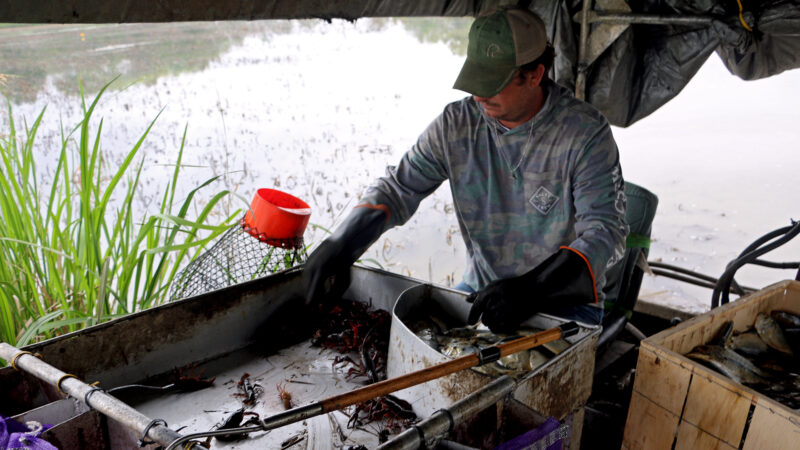Babec’s Pacemaker
It is a bright, sunny day at the Birmingham Zoo and Babec is training. The 345-pound gorilla stands at his cage door doing what seems like an elaborate form of the hokey pokey. The incentive? Babec’s favorite treats and some whipped cream. But this is about more than just a little snack. Babec has to learn to present his chest when asked so his keeper and doctors can get a reading on his pacemaker.
“Babec’s training consists of him presenting his body parts on cue and he will present those body parts and what we’ve done is work him up to presenting his chest and his chest is what needs to be presented at the side of the cage and that’s for us to put the wand over to read his CRT {pacemaker}.”
Primate keeper Denise Monroe puts Babec through his paces most days. She says while Babec is getting better about doing what she asks training’s not been easy.
“Babec, he’s been stubborn in some ways because he is not as food driven as some animals. If you don’t offer him the reward that is special enough to him he could care less about training, he would rather ignore you.”
Scientists have known for years that gorillas in captivity are at risk of developing cardiac disease; Head Zoo Veterinarian Dr. Marie Rush says they just aren’t sure why.
“A very large number of gorillas, especially male gorillas over the age of thirty will develop cardiac disease. We’re very fortunate that in captivity we can monitor that, in the wild this probably also happens as well.”
The normal course of treatment for a Great Ape with a heart problem is medications similar to what you or I would take — they worked for a while for Babec, but not long enough. A local newspaper did a story on Babec’s plight and Rush says it wasn’t long after that she was contacted by representatives of Guidant, a company that makes pacemakers for humans. The reps suggested a pacemaker for Babec.
“I said we’ve talked about this in this business for several years but it’s not really been considered feasible in these guys because of maintenance and size and the need for special equipment. Well, that lead to a further discussion and the need to do something for him.
So, Rush says, they decided to go for it. The zoo pulled together a team of specialists from Auburn University, the University of Alabama at Birmingham and private practice to perform the procedure on the gorilla. UAB’s Dr. Neal Kay is an expert on pacemakers in humans and implanted the device in Babec.
“The anatomy of the gorilla was actually very similar to the human anatomy. As you might expect the gorilla’s muscles were bigger than a man’s but the operation went very smoothly and what was really quite gratifying was how well the gorilla did. He went from really being at the point of death to making dramatic improvement.”
But there was a hairy moment in Babec’s progress. He had to undergo the procedure a second time, just this past spring, after a tussle with his roommate Jamie, a younger silverback. During the fight the wires that control Babec’s heart’s functcion came loose. But the team was quickly reassembled and the wires replaced. He hasn’t had any problems since, all though Mammal Curator Marcia Riedmiller says the two don’t really live together anymore.
“To this day … we’ve made the decision, management-wise in husbandry to keep them separate. We do feel that Jamie probably knows Babec’s compromised.”
While the pacemaker’s doing wonders for Babec now, it could provide a wealth of information for primate researchers in the future. All readings of gorilla hearts up to this point have been made while the animals were sedated. Babec’s pacemaker will give readings of his heart while he’s awake. Those readings could help clue scientist in on why gorillas develop heart disease. But most importantly, Dr. Neal Kay says, the pacemaker will make Babec’s, and other gorillas’, lives easier.
And there may be more gorillas getting pacemakers. Rush says she’s getting calls from other zoos about the procedure and there’s the possibility the Birmingham Zoo could become a kind of cardiac care center for gorillas in the future.
“Albeit sounding like a pipedream I’m hopeful that maybe in the future that is something that we could consider and maybe that’s something that we could do.”
Until then they’ll have their hands full caring for their first patient.
Alabama’s racial, ethnic health disparities are ‘more severe’ than other states, report says
Data from the Commonwealth Fund show that the quality of care people receive and their health outcomes worsened because of the COVID-19 pandemic.
What’s your favorite thing about Alabama?
That's the question we put to those at our recent News and Brews community pop-ups at Hop City and Saturn in Birmingham.
Q&A: A former New Orleans police chief says it’s time the U.S. changes its marijuana policy
Ronal Serpas is one of 32 law enforcement leaders who signed a letter sent to President Biden in support of moving marijuana to a Schedule III drug.
How food stamps could play a key role in fixing Jackson’s broken water system
JXN Water's affordability plan aims to raise much-needed revenue while offering discounts to customers in need, but it is currently tied up in court.
Alabama mine cited for federal safety violations since home explosion led to grandfather’s death, grandson’s injuries
Following a home explosion that killed one and critically injured another, residents want to know more about the mine under their community. So far, their questions have largely gone unanswered.
Crawfish prices are finally dropping, but farmers and fishers are still struggling
Last year’s devastating drought in Louisiana killed off large crops of crawfish, leading to a tough season for farmers, fishers and seafood lovers.







